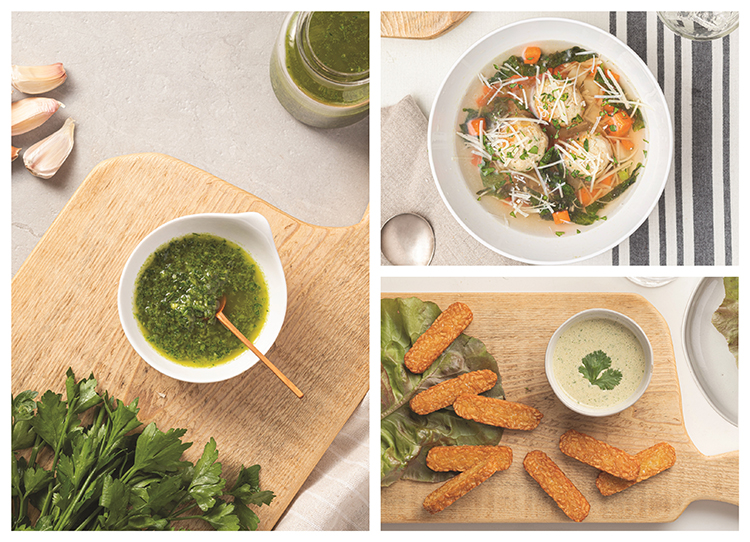
(CLOCKWISE FROM LEFT) GREEN OIL, MEATBALL, AND ESCAROLE SOUP, TEMPEH STICKS WITH CILANTRO DIP.
What is inflammation, and how can the diet affect it? According to the National Cancer Institute, inflammation is a normal physiological response that causes injured tissue to heal. An inflammatory process starts when the damaged tissue releases chemicals. In response, white blood cells make substances that cause cells to divide and grow to rebuild tissue to help repair the injury. Once the wound is healed, the inflammatory process ends.
In chronic inflammation, the inflammatory process may begin even if there is no injury, and it does not end when it should. Why the inflammation continues is not always known. Chronic inflammation may be caused by infections that don’t go away, abnormal immune reactions to normal tissues, or conditions such as obesity. Over time, chronic inflammation can cause DNA damage and lead to cancer. For example, people with chronic inflammatory bowel diseases, such as ulcerative colitis and Crohn’s disease, have an increased risk of colon cancer.
It’s well-known that inflammation-fighting foods like avocadoes, berries, and broccoli are just some that help keep the immune system strong. More information on how to incorporate anti-inflammatory foods into the daily diet can be found in The Anti-Inflammatory Family Cookbook by a physician-chef collaboration of authors. Combining science, art, and the practice of anti-inflammatory eating into a user guide, the cookbook offers 100 easy-to-follow, healthy recipes, many with beautiful color photographs.
The author group includes Stefania Patinella, Alexandra Romey, and Johnathan Deutsch – all chefs with expertise in culinary nutrition, herbalism, food product development, menu design, and education. Pediatricians Dr. Hilary McClafferty and Dr. Maria Mascarenhas are experts in integrative health and preventive medicine.
Try the Green Oil, an herb mixture of parsley, rosemary, chives, and garlic. The authors say that parsley is “said to be especially good for kidney health and a good source of antioxidants. Tempeh Sticks with Cilantro Oil incorporates cilantro, rich in vitamins A and K. Meatball and Escarole Soup combines chickpeas and turkey for the meatballs in a delicious stew of carrots, celery, red potatoes, and escarole.
Three recipes we like from the book are Green Oil, Meatball and Escarole Soup, and Tempeh Sticks with Cilantro Dip. Here is one. See the others in Healthy Aging® Magazine.
 Tempeh Sticks with Cilantro Dip
Tempeh Sticks with Cilantro Dip
Makes 4 servings
- 1 large bunch cilantro
- 2 tablespoons tahini
- 2 teaspoons miso
- 1 tablespoon lemon juice
- 1 tablespoon pure maple syrup
- 1 teaspoon apple cider vinegar
- 3⁄4 teaspoon salt, divided
- 2 tablespoons coconut oil
- 1 (8-ounce) package tempeh, cut crosswise into 1⁄4″ strips
Trim and discard stem tips of cilantro. Break bunch in half with your hands, rinse well and place in the bowl of a food processor.
Add tahini, miso, lemon juice, maple syrup, vinegar, and 1⁄4 teaspoon salt to food processor and process until smooth, stopping to scrape down the bowl a couple of times. Taste and adjust seasoning if desired. Set aside.
Heat oil in a large skillet over medium heat. Add tempeh strips, sprinkle with 1⁄4 teaspoon salt, and cook 3–4 minutes until they are golden brown on the underside. Flip them (two forks work well for this), season with remaining salt, and cook on other side another 3–4 minutes. Add a bit more oil to pan if needed.
Place tempeh on a serving dish and spoon sauce over it. Or serve separately as sticks and dip.













